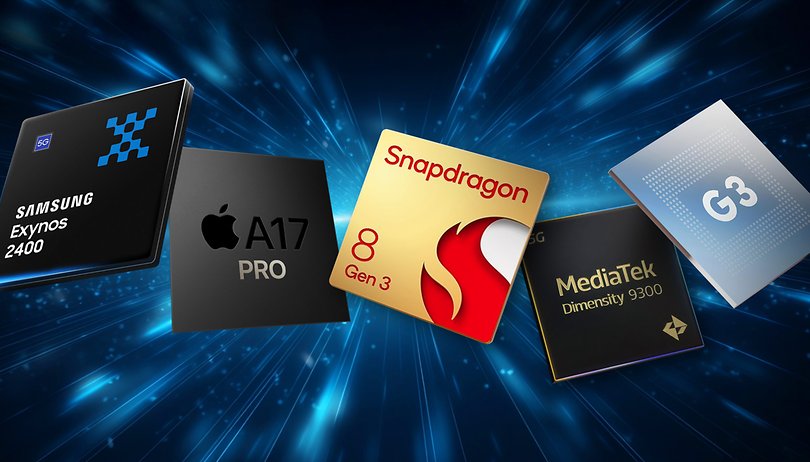Best Mobile Processors: How to Choose What You Need
 Shubhajit Mondal
Shubhajit Mondal
What is the "Gen" Number?
The "Gen" (generation) number indicates how advanced a processor is within its series. Higher generations (e.g., Gen 3 vs. Gen 1) typically offer:
Better CPU and GPU performance
Improved power efficiency
New features like advanced AI and faster 5G
Breakdown of Mobile Processor Series
Snapdragon (by Qualcomm)
Snapdragon 4 Series:
Category: Budget version (affordable phones)
Examples: Snapdragon 4 Gen 1, Snapdragon 4 Gen 2
Use Case: Basic tasks (calls, browsing, social media)
Snapdragon 6 Series:
Category: Mid-range version (good performance at a lower cost)
Examples: Snapdragon 6 Gen 1, Snapdragon 680
Use Case: Moderate tasks (gaming, multitasking, photography)
Snapdragon 7 Series:
Category: Upper mid-range version (solid performance)
Examples: Snapdragon 7 Gen 1, Snapdragon 7s Gen 2, Snapdragon 7 Gen 3
Use Case: Gaming, multitasking, and better power efficiency
Snapdragon 8 Series:
Category: High-end flagship version (best performance)
Examples: Snapdragon 888 5G, Snapdragon 8 Gen 1, Snapdragon 8+ Gen 1, Snapdragon 8 Gen 2, Snapdragon 8 Gen 3
Use Case: Premium performance (high-end gaming, photography, multitasking, 5G)
MediaTek Dimensity (by MediaTek)
Dimensity 6000 Series:
Category: Mid-range version
Examples: Dimensity 6100+, Dimensity 6080
Use Case: Everyday tasks and casual gaming
Dimensity 7000 Series:
Category: Upper mid-range version
Examples: Dimensity 7050, Dimensity 7200
Use Case: Better gaming, multitasking, and photography
Dimensity 8000 Series:
Category: High-end version
Examples: Dimensity 8100, Dimensity 8200, Dimensity 8300
Use Case: Gaming, video editing, 5G, and heavy multitasking
Dimensity 9000 Series:
Category: Flagship version (comparable to Snapdragon 8 series)
Examples: Dimensity 9000, Dimensity 9200
Use Case: Premium flagship performance for top-tier devices
Exynos (by Samsung)
Exynos 800 / 900 Series:
Category: Budget to mid-range versions
Examples: Exynos 850, Exynos 9611
Use Case: Basic to moderate tasks (social media, browsing, light gaming)
Exynos 1200 / 1300 Series:
Category: Mid-range versions
Examples: Exynos 1280, Exynos 1380
Use Case: Moderate gaming and multitasking in mid-range Samsung devices
Exynos 2000 Series:
Category: High-end/flagship versions
Examples: Exynos 2100, Exynos 2200
Use Case: High-end gaming, multitasking, and top-tier camera performance, comparable to Snapdragon 8 series
Unisoc
Unisoc processors are mainly found in entry-level smartphones:
Unisoc T606:
Category: Entry-level
Use Case: Basic tasks like calls, messaging, and light browsing in very affordable smartphones
Apple A-Series (for iPhones)
A-Series (Flagship Version):
Category: Best-in-class performance for iPhones
Examples: Apple A14 Bionic, Apple A15 Bionic, Apple A16 Bionic, Apple A17 Pro
Use Case: Superior gaming, AI processing, photography, and overall performance with seamless iOS optimization
Google Tensor (by Google)
Tensor Series:
Category: Optimized for Google Pixel phones
Examples: Tensor G1, Tensor G2
Use Case: Excellent for AI tasks, photography, and Google’s software integration
Summary of Processor Tiers
Budget Processors:
Snapdragon 4 Series (4 Gen 1, 4 Gen 2)
MediaTek Dimensity 6100+
Exynos 850
Mid-Range Processors:
Snapdragon 6 Series (6 Gen 1)
Snapdragon 7 Series (7 Gen 1, 7s Gen 2)
MediaTek Dimensity 7050 / 7200
Exynos 1280 / 1380
High-End/Flagship Processors:
Snapdragon 8 Series (888 5G, 8 Gen 1, 8+ Gen 1, 8 Gen 3)
MediaTek Dimensity 8200 / 8300 / 9000
Exynos 2100 / 2200
Apple A-Series (A14, A15, A16, A17)
Google Tensor (G1, G2)
Here is a general breakdown of CPU clock speeds for the processors mentioned:
Snapdragon (by Qualcomm)
Snapdragon 4 Series:
- Snapdragon 4 Gen 1 / Gen 2: Up to 2.0 GHz
Snapdragon 6 Series:
Snapdragon 6 Gen 1: Up to 2.2 GHz
Snapdragon 680: Up to 2.4 GHz
Snapdragon 7 Series:
Snapdragon 7 Gen 1: Up to 2.4 GHz
Snapdragon 7s Gen 2 / Gen 3: Up to 2.5 GHz
Snapdragon 8 Series:
Snapdragon 888 5G: Up to 2.84 GHz
Snapdragon 8 Gen 1: Up to 3.0 GHz
Snapdragon 8+ Gen 1: Up to 3.2 GHz
Snapdragon 8 Gen 2 / Gen 3: Up to 3.36 GHz
MediaTek Dimensity (by MediaTek)
Dimensity 6000 Series:
- Dimensity 6100+ / 6080: Up to 2.2 GHz
Dimensity 7000 Series:
- Dimensity 7050 / 7200: Up to 2.8 GHz
Dimensity 8000 Series:
- Dimensity 8100 / 8200 / 8300: Up to 3.1 GHz
Dimensity 9000 Series:
- Dimensity 9000 / 9200: Up to 3.05 GHz
Exynos (by Samsung)
Exynos 800 / 900 Series:
Exynos 850: Up to 2.0 GHz
Exynos 9611: Up to 2.3 GHz
Exynos 1200 / 1300 Series:
- Exynos 1280 / 1380: Up to 2.4 GHz
Exynos 2000 Series:
Exynos 2100: Up to 2.9 GHz
Exynos 2200: Up to 2.8 GHz
Unisoc
- Unisoc T606: Up to 1.6 GHz
Apple A-Series (for iPhones)
A14 Bionic: Up to 3.1 GHz
A15 Bionic: Up to 3.23 GHz
A16 Bionic: Up to 3.46 GHz
A17 Pro: Up to 3.70 GHz
Google Tensor (by Google)
Tensor G1: Up to 2.8 GHz
Tensor G2: Up to 2.85 GHz
These speeds can vary slightly depending on the device and thermal conditions. The higher-end processors typically have more cores and advanced architecture to provide better performance for gaming, multitasking, and AI tasks.
Here's a table outlining clock speeds for different levels of mobile gaming, from casual to high-end flagship gaming.
| Gaming Level | Recommended Clock Speed | Example Processors | Use Case |
| Casual Gaming | Up to 2.2 - 2.4 GHz | Snapdragon 6 Gen 1, Dimensity 6100+, Exynos 9611 | Light gaming, casual games, social apps |
| Good Level Gaming | 2.4 - 2.8 GHz | Snapdragon 7 Gen 1, Dimensity 7050, Exynos 1280 | Moderate gaming (PUBG, Call of Duty on medium settings) |
| High-Level Gaming | 2.8 - 3.1 GHz | Snapdragon 8 Gen 1, Dimensity 8100, Tensor G2 | Advanced gaming, high graphics, multitasking |
| Flagship Gaming | Above 3.1 GHz | Snapdragon 8 Gen 2/3, Dimensity 9200, A17 Pro | Premium gaming, ultra-high settings (Genshin Impact, Fortnite on max settings) |
Explanation:
Casual Gaming is suitable for users playing games that don’t require heavy processing, like Candy Crush, Subway Surfers, or Angry Birds.
Good Level Gaming includes games with moderate graphics requirements such as Call of Duty Mobile and PUBG Mobile on medium settings.
High-Level Gaming supports heavier titles like Fortnite or Asphalt 9 on high settings.
Flagship Gaming is for the most demanding games with the highest settings and smooth gameplay, focusing on Snapdragon 8 Gen 3 and Apple A17 Pro for professional gamers.
This table helps you choose the right processor based on the gaming experience you want!
Subscribe to my newsletter
Read articles from Shubhajit Mondal directly inside your inbox. Subscribe to the newsletter, and don't miss out.
Written by

Shubhajit Mondal
Shubhajit Mondal
while (alive) { eat(); sleep(); code(); repeat(); }